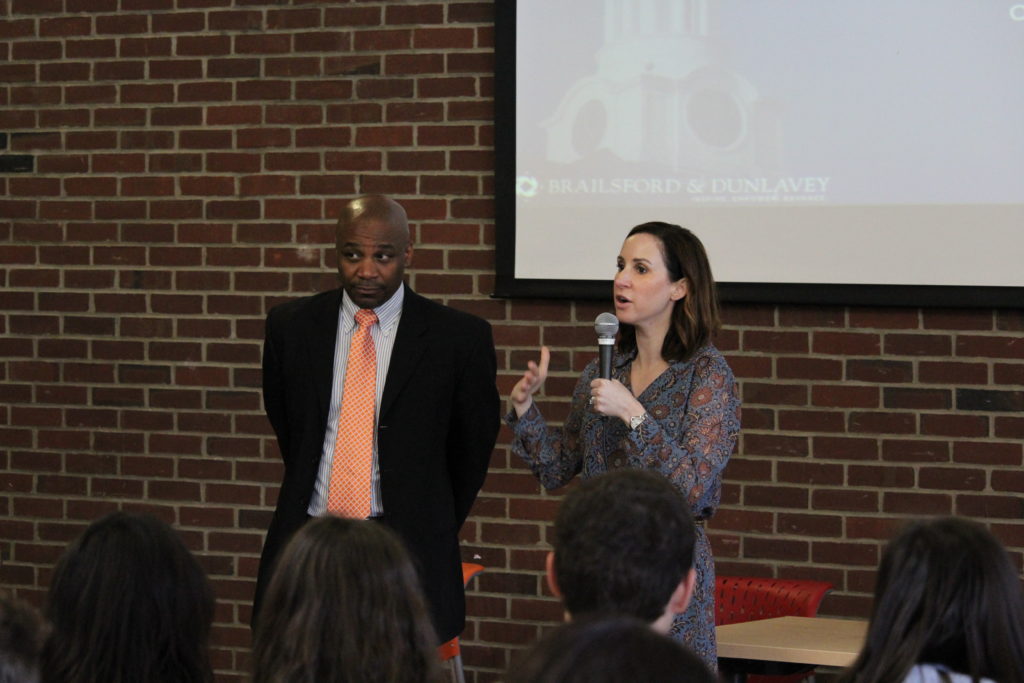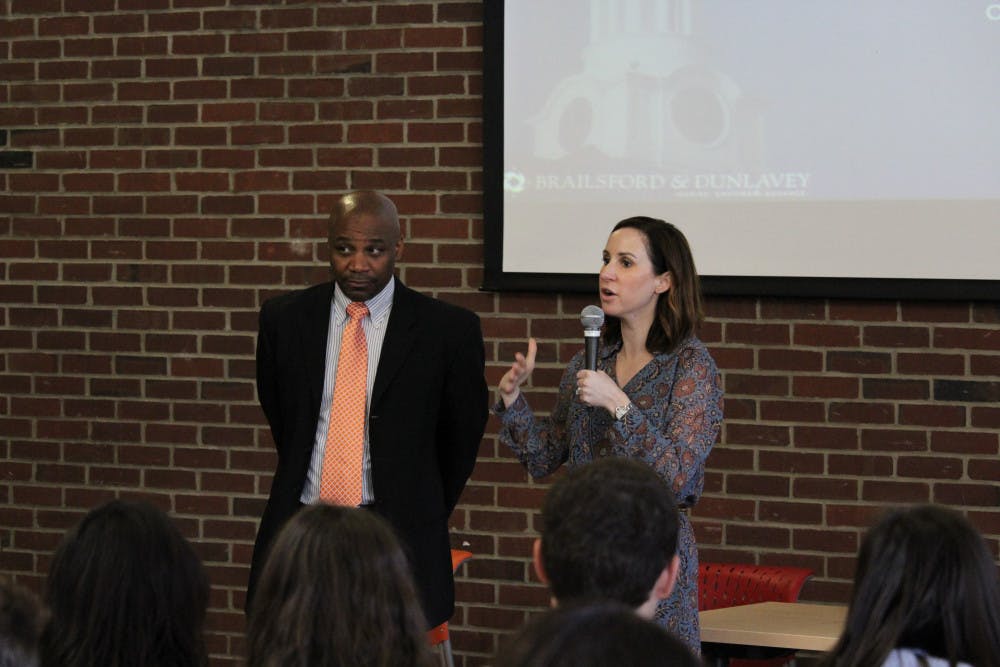By Elizabeth Zakaim
Social Media Editor
It was an ironic place for a meeting: In the lounge between Travers and Wolfe halls, the program management firm Brailsford & Dunlavey (B&D) held a forum to inform attendees of the administration’s plan to destroy both buildings.
On Wednesday, Oct. 27, B&D presented its market analysis, developed from student input regarding what they like about the towers, and shared with Student Government (SG) members what they plan to implement in the new construction of freshman-year dorm life.
According to B&D consultant Alan Resnick, the new building would be built in front of the Towers, leading all the way to where the tennis courts currently stand. The firm proposed that the tennis courts would be rebuilt closer to where other athletic fields are, past Packer Hall.
Representatives from B&D showed an effort to reproduce the green space that would be swallowed up by the new construction. Resnick proposed that the land where the Towers stand now could be turned into efficient green space later down the road.
Assistant Vice President of Student Affairs Sean Stallings described the unseen danger the Towers currently pose to residents’ health and safety.
“If left unchecked, (these dangers) can have a catastrophic impact on the student experience,” Stallings said.
Heating systems installed when the 45-year-old buildings were first built, as well as leaking pipes, can have a long-term effect over the years, according to Brenden Kollar, a B&D consultant who spoke at the forum.
Kollar said it would be cheaper to renovate, but not by much. According to the consultant, the cost of renovating is 73 percent of the cost of new construction, and that saving 27 percent of that cost for renovations is not worth it in the long run, as renovations often requires further repairs in the future. It’s like buying a car, Kollar said.

“If you buy a used car, you know you’re gonna have issues as you move forward compared to a new car that has all the latest technology,” he said.
Lloyd Ricketts, the College’s vice president and treasurer, crunched the numbers to figure out the cost discrepancy.
“The numbers I saw for the renovation cost was about $85 million,” Ricketts said. “Let’s say we take two years to renovate. That’s another $18 million added onto the cost. The renovation cost, plus the forgone money from having one tower closed at a time, would be equal to the cost of new construction.”
Renovation would mean a huge revenue loss for the College, even just one tower was renovated at a time, Vice President of Student Affairs Amy Hecht said.
“If we were to renovate, it would take about one-and-a-half to two years per tower,” Hecht said. “During that time, we’ll lose about 500 beds. We’ll also lose $4.5 million per tower in revenue.”
Ricketts also noted that the loss in revenue and the cost to renovate would have to be compensated.
“The College is required to balance its budget every year,” Ricketts said. “So, the College would be forced to cut expenses, lay people off… or raise tuition and housing so exorbitantly to close the gap.”
The College would need to borrow around $95 million to renovate or construct, he explained, but the likelihood of receiving a loan to construct is much higher than receiving a loan to renovate buildings as old as the towers.
Construction would mean that freshmen would still be able to live in the towers while the new dorms were being built, whereas about 500 people would be displaced while one tower was being renovated. According to Kollar, new construction would start in five years and last about two years.
Nicole Herrmann, a member of SG and a senior marketing major, proposed that the construction in front of the towers would isolate the freshmen and discourage prospective students and their parents from choosing the College over other schools.
In response, Hecht said admissions officers received feedback from families who decided not to come here. The feedback found that many of the families were mostly deterred by the current state of the towers that they observed during their tours.
In B&D’s survey conducted last spring, they found that students most wanted to see improvements on the current air conditioning and lack of Wi-Fi. According to Kollar, the current concrete block structure of the towers inhibits the ability for Wi-Fi to transmit itself throughout the buildings.
No more towers means saying goodbye to T-Dubs, too. Stallings said he asked the team if there was a way to keep the beloved dining space. However, due to a utilities issue, keeping T-Dubs would not be feasible.
“What we discovered was that in the 1970s, they thought it was a good idea to put the electricity on one side, Travers, and put the water on the other side, Wolfe, and so, when we tear these down, (the T/W lounge and T-Dubs) would sit here with no utilities,” Stallings said.
However, the College is thinking about converting parts of the Brower Student Center into a late night dining space for students.
The new buildings would not have the “quad spaces” that the towers do, according to Kollar. The quads in the towers were originally lounges that were made into bedrooms to fit four people inside. Hecht also explained that both freshmen and sophomores would be living in the new building in order to reduce the “downgrade” freshmen would experience moving from a brand new building freshman year to an older building sophomore year.
Some members of SG were concerned about the decrease in the number of beds in the new building. Stallings explained that the new building would have about 200 fewer beds than the towers, which currently have around 1,100 beds.
When asked about the downsize, Stallings said the College currently doesn’t fill up those 200 beds in the fall, and that the vacancy only increases in the spring when students transfer, face academic dismissal or study abroad.
One SG member was concerned that a building would cost more to build but house fewer people would be a waste of money and an inconvenience. Ricketts explained that the 200 extra beds are currently not being occupied, and the money being spent to pay for them is not being compensated.
The College budgets about 96 percent of the total occupancy in the towers, which leaves room for vacancy. According to Ricketts, the best practice would be to fill all of those beds, but that is not always possible.
Sophia Grigolo, a member of SG and a sophomore criminology major, said the forum helped her understand the situation better, but that the issue of the decrease in beds still remains.
“I really feel like the representatives avoided confirming the loss of beds,” she said. “They didn't entirely deny that there will be significantly less beds. They say that they want our school to grow, and it is, but if we aren't accommodating for the increased amount of new students each year, upperclassmen and the campus, as a whole, will feel the effects.”
Christopher Blakely, vice president of Administration and Finance and a sophomore civil engineering major, is also a bit skeptical about decreasing the number of beds. He wanted to see the numbers before forming an opinion.
Alex Molder, vice president of Academic Affairs and a sophomore finance major, acknowledged the legitimacy of both claims and understands that accepting change can be difficult.
“There is undoubtedly comfort in familiarity,” he said. “For this reason, the change, regardless of what it is, will be met with some resistance.”







